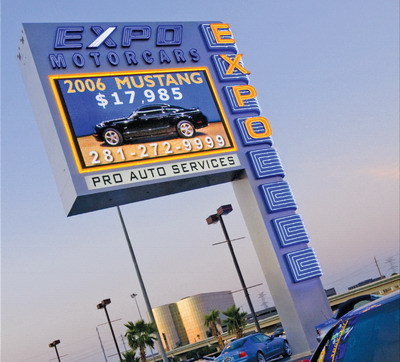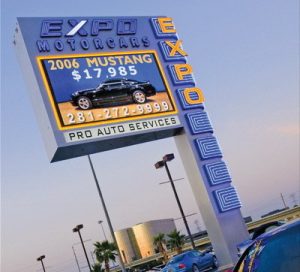In Utah, last month, I passed a car dealership that had a large, color display. It was perfectly sized and placed, with a very long read. But, I watched, aghast, as red, block letters in a 24-in. Arial font slowly scrolled down from the top with some blather about a “Manager’s Special.”
From my inside-the-industry perspective, I estimated the sign cost roughly $650,000. I also think its owner doesn’t consider it a good investment. Sickening. Kind of like buying a Ferrari to deliver pizzas.
A day later, in Las Vegas, I drove by a convenience store with a 32 x 80-ft., color LED display on the pylon in front of it. So, I parked and entered the store to verify the sign’s dimensions and ask who programmed the sign. It was awesome!
Four, very clearly defined advertising concepts were carefully depicted, with good display effects and timing. Within half a block, the sign had drawn me into the store.
The store itself wasn’t spectacular – it was over-stuffed with all things C-store – but you could tell it was a place where someone with pride had invested extra effort.
I asked the woman behind the counter who had programmed the sign. She beamed with a quick reply, “That would be me.” I complimented her on her work, and she told me it was important to her.
Advertisement
My reaction to those two signs dramatically changed my focus as I now travel and view displays. For years, I’ve been obsessed with such technical issues as brightness, uniformity, color clarity and contrast. Since that week last December, my attention has been drawn to presentation and content.
And I’m concerned.
There seems to be a real disconnect between the display product’s capabilities and its actual use. For those of us who produce and sell the display, it’s disheartening to see the medium so underutilized.
I doubt if the Utah car dealer has sold many cars or service programs from his digital display. It’s a terrific sign, but the programming renders it useless. Yet, the C-store’s $20,000 sign has definitely brought additional business to its owner. I personally reacted to the sign.
As display builders and sign companies, we uniquely sell our products and services. We sell technology that presents concepts created by others. The technology may perform flawlessly, but, if the content or presentation is weak, the equipment we’ve sold doesn’t bring the intended result.
In both examples I’ve cited, the technology perfectly matched the application. The car dealership sign suited its location and type of business. Likewise, the 32 x 80-ft. display was well-suited to the C-store. Yet, one sign produced the desired result.
Advertisement
This issue is particularly timely. As I write this, our economy seems to be tumbling out of control. Whereas most of 2007 and 2008 were awash with sales opportunities, 2009 could become a fear-driven bust. In my last column, I advocated prospecting for new opportunities and leading with the advertising value of the technology. Last month’s experience reminded me that the ad value isn’t in the technology. The technology only facilitates the advertising, good or bad.
What to do?
What we need is a creative resource for digital-display-advertising content packaging. Ultimately, that resource could be radically different for each application and business.
In the convenience-store example, a well-meaning clerk empowered that display with simple messages, which were diligently changed on a timely basis. For many displays, that’s all that’s needed. Clearly a mandate should guide those of us who sell these signs to teach our customers how to get the best results from our products.
Or, better still, offer the customer a programming agreement. Chances are, the sign’s programming will become an afterthought for the business manager. Let’s face it, it’s a challenge to find a well-meaning employee who will invest as much effort into store promotion as the C-store clerk. Unless an individual has been clearly tasked and scheduled to make timely display updates, it will become somebody else’s hassle.
In addition to selling the sign, we should also sell the service of operating the sign. One day each week, email the store operator, and ask what he or she wants to promote. Ask what’s on sale and the price. From the response, you can create messages suited to the sign and its length of visibility – day-parted messages that will hit buyers when they are most likely to buy. Create engaging display effects that draw attention to the messages. In less than an hour, you can pre-program the display with a week’s worth of winning content.
Advertisement
For a simple display, charge only $150 a month. If the sign is new, you can sell it without a controller, which saves the owner the component cost. If he hesitates, ask him to try it for a month or two. With very little effort, you’ll have him for the life of the sign. Show the customer how he or she might recover some advertising costs by claiming co-op credits from the manufacturers of the featured products.
For a major display, such as a car-dealership sign, consider various options. Depending on your level of sophistication and creativity, you could provide the same service previously noted. However, these ads deserve more weighty consideration.
Spend some quality time with the customer to understand the company’s vision, the products offered and the services rendered. Also, if appropriate, consult with the ad agency involved.
A large-scale LED display, with good visibility on a well-traveled thoroughfare, can be a valuable advertising medium. A talented, creative person can create dynamic messages. Also, all programmed displays should follow a good business model. A large-format display should command at least $400 per month in programming fees.
If your primary goal is to just sell and service displays, then, by all means, take the time to seek out a programming professional who can assist your customer. Most premium display manufacturers offer a service as an extension of their business and/or know content-creation agencies and programming services that could add tremendous value to your customer. Helping the customer to develop such a relationship ensures that the product you sell will be valuable for years to come.
Learn and teach the new features
Today’s equipment offers so many dynamic features that, when properly utilized, can turn a display into a recognized landmark. For example, displays can be programmed to interact with websites to gather information for automatic updates.
Picture this: Lottery numbers usually change at midnight. Signs throughout the state could suddenly reveal the new numbers at 12 a. m. sharp. Those signs were set to reach out to the lottery website at midnight to get those numbers. The new numbers were set into the display image, exactly where it was formatted.
Consider an ad for a television station that announces the evening news team with current stories every evening during drive-time. Those stories are updated automatically through a utility set to draw the information from the station‘s website.
Now, imagine an ad that automatically appears on a heating/cooling company sign that says, “Wow, it‘s 90°. Call us for an AC checkup.” That ad was pre-set to appear when the temperature hits 90°.
The equipment we sell is only half the equation. A car doesn’t perform without a driver, regardless of its horsepower. Thus, we must sell the entire package, or at very least, ensure our customers can access the tools they need.
Selling the display should begin our relationship with that customer. As good business people, we need to help our customers understand that equipment installation is just the beginning of that relationship, and we’ll be there for the duration. We’ll provide service and software upgrades as features are added and assist with programming, either directly or as a referral. Let’s turn our display sales into advertising solutions.



 Photo Gallery2 weeks ago
Photo Gallery2 weeks ago
 Paula Fargo1 week ago
Paula Fargo1 week ago
 Real Deal7 days ago
Real Deal7 days ago
 Photo Gallery1 week ago
Photo Gallery1 week ago
 Projects7 days ago
Projects7 days ago
 Women in Signs2 weeks ago
Women in Signs2 weeks ago
 Signs of the Times2 weeks ago
Signs of the Times2 weeks ago
 Business Management6 days ago
Business Management6 days ago










